This post may contain affiliate links. Please read our disclosure policy.
How to remove turmeric stains from clothes, linens, countertops, tableware, and more! These turmeric stain removal methods require simple household materials and are quick and easy to deal with – so you no longer have to panic over yellowed turmeric stained materials again!
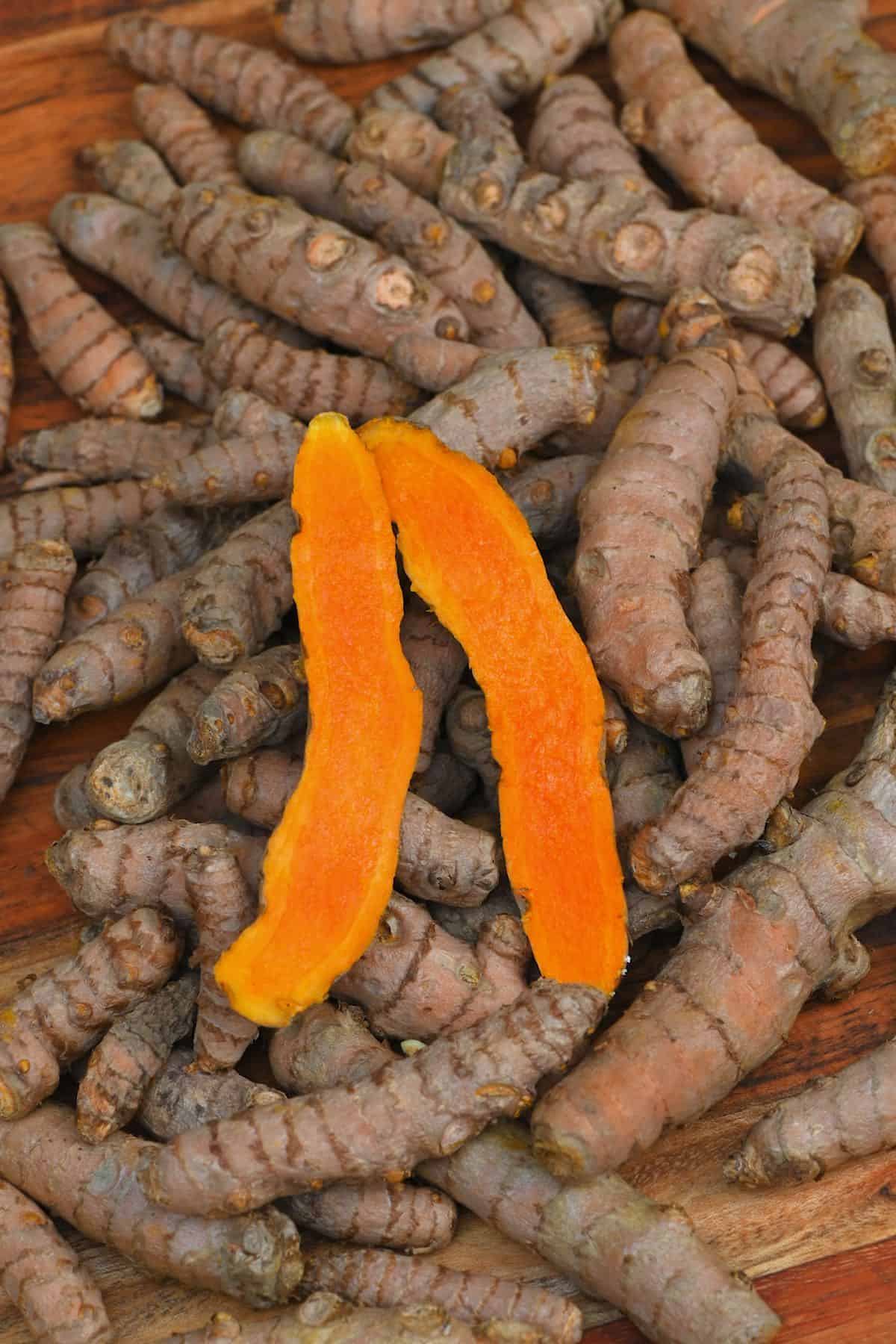
If you’ve spent much time (or any at all) dealing with turmeric (fresh or powdered), then you’ve likely dealt with yellow fingers (at the very least). However, with golden milk, turmeric tea, and plenty of curries/Indian food (among many other turmeric recipes) to enjoy, at some point, you’re likely to run into a problem, because as healthful as this ingredient is…. turmeric stains everything! Countertops, linens, tableware, and fingers alike will become yellow when left in contact with turmeric for too long (uh-oh).
Turmeric is related to the ginger family and has a highly saturated golden-yellow/orange pigment that is used as a natural dye for foods AND materials (which is how you know that stains won’t be easy to remove!).
Luckily, since I pretty much spend my life in my kitchen, I’ve seen and dealt with stains galore – turmeric, beetroot, coffee, etc. That’s how I’ve picked up on the best tips and tricks to be able to answer “how to remove turmeric stains” out of clothes/linens, tableware/kitchen tools, countertops, and more!
Want to save this recipe?
Top Tips When Working With Turmeric
I’ll take a guess that you’ve found your way to this page because you’re trying to remove a turmeric stain. However, since prevention is always best, here are some of my top tips to reduce the likelihood of having to deal with bad turmeric stains.
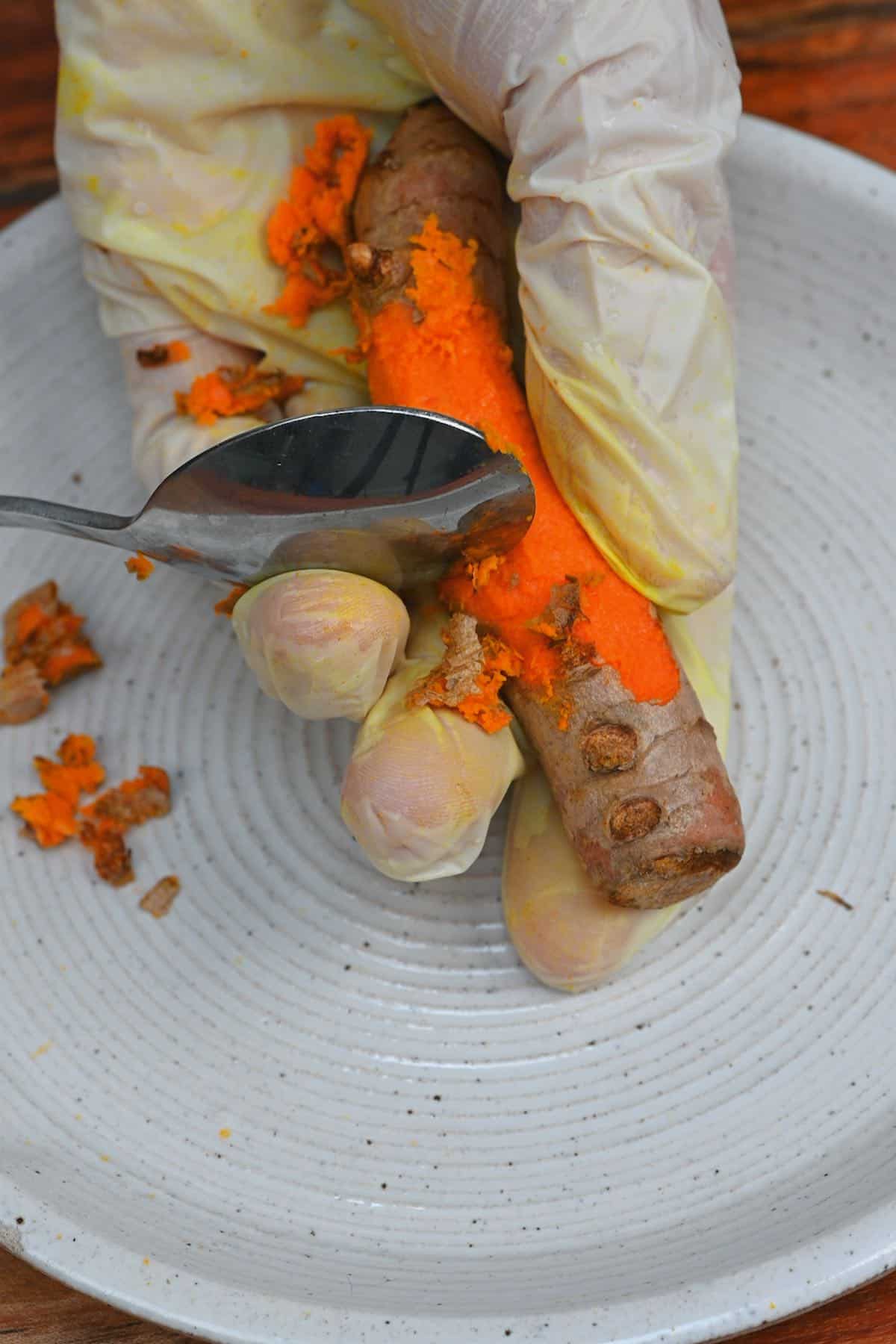
- Wear protective clothing: please don’t wear white when dealing with turmeric – that’s asking for a nightmare. However, being more practical, I recommend always using protective gloves when dealing with turmeric. Even better, use an old apron, if you have one (just in case). At a bare minimum, definitely invest in some protective gloves.
- Use the best surface: turmeric will stain certain surfaces quicker than others (i.e. wood and other porous surfaces). To avoid surface turmeric stains, I recommend using something slightly less porous, like glass.
- Wash EVERYTHING immediately: a great way to avoid stains “settling”, is to wash everything immediately when/after dealing with turmeric, including:
- Hands – wash your hands immediately with soap. Use a brush to get under your nails, if needed.
- Tools – such as the chopping board/knife, etc. Rinse immediately with water. Use soap on porous chopping boards.
- Counter tops – if you notice a splatter or drop of turmeric drop onto your counter top at any time then wipe it immediately and this should stop the stains from settling.
- Clothes – rinse the item of clothing immediately then soak in cold water (not hot, which can cause the stain to set!) with a mild detergent. You could also use a “stain remover” product. The sooner, the better.
The Materials You’ll Need
Though the various methods differ, based on the item that’s stained, there are several materials that appear time and time again. Here is a full list of these materials – it may be handy to keep some “on-hand”.
- Baking Soda,
- Cornstarch,
- White vinegar,
- Hydrogen peroxide,
- Lemon juice,
- Magic Eraser,
- Cleaning cloth,
- A spare/old toothbrush,
- Detergent (dish and clothing),
- Rubbing alcohol.
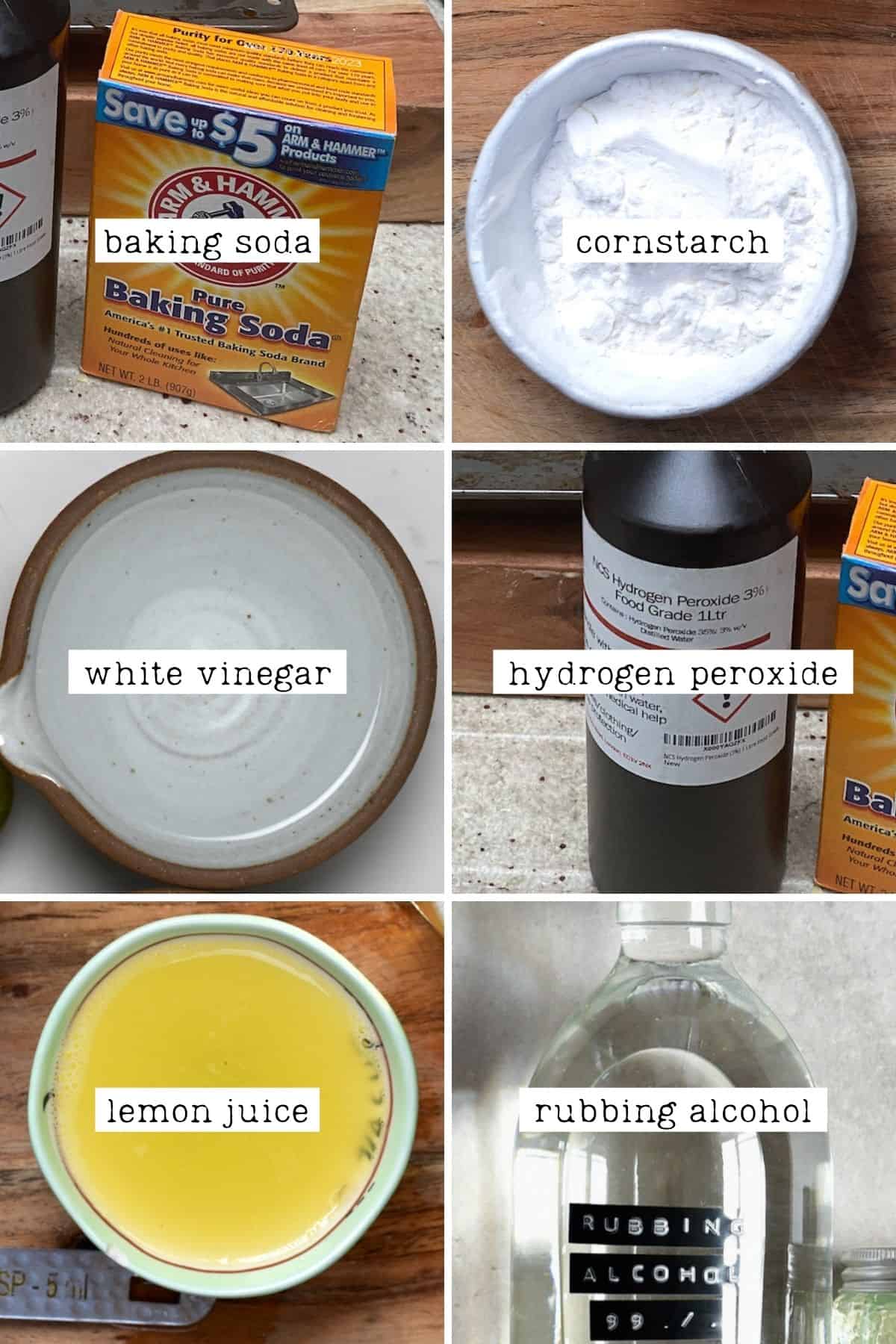
How to Remove Turmeric Stains?
From Hands
Unfortunately, when it comes to our skin, turmeric stains can be downright stubborn, even with the below cleaning method. However, this should help to fade the stains sooner. In the meantime, invest in kitchen gloves so you never have to deal with this issue again.
- First, wash your hands thoroughly with hot soapy water. Then use lemon juice to rub over your hands/fingers (don’t do this if you have any cuts!) and, if possible, use a hand brush (or an old toothbrush) to gently scrub your skin.
- Then rinse your hands and wash once more with soapy water. You can repeat this 2-3 times. However, lemon can dry out the skin – so use a hand moisturizer if needed.
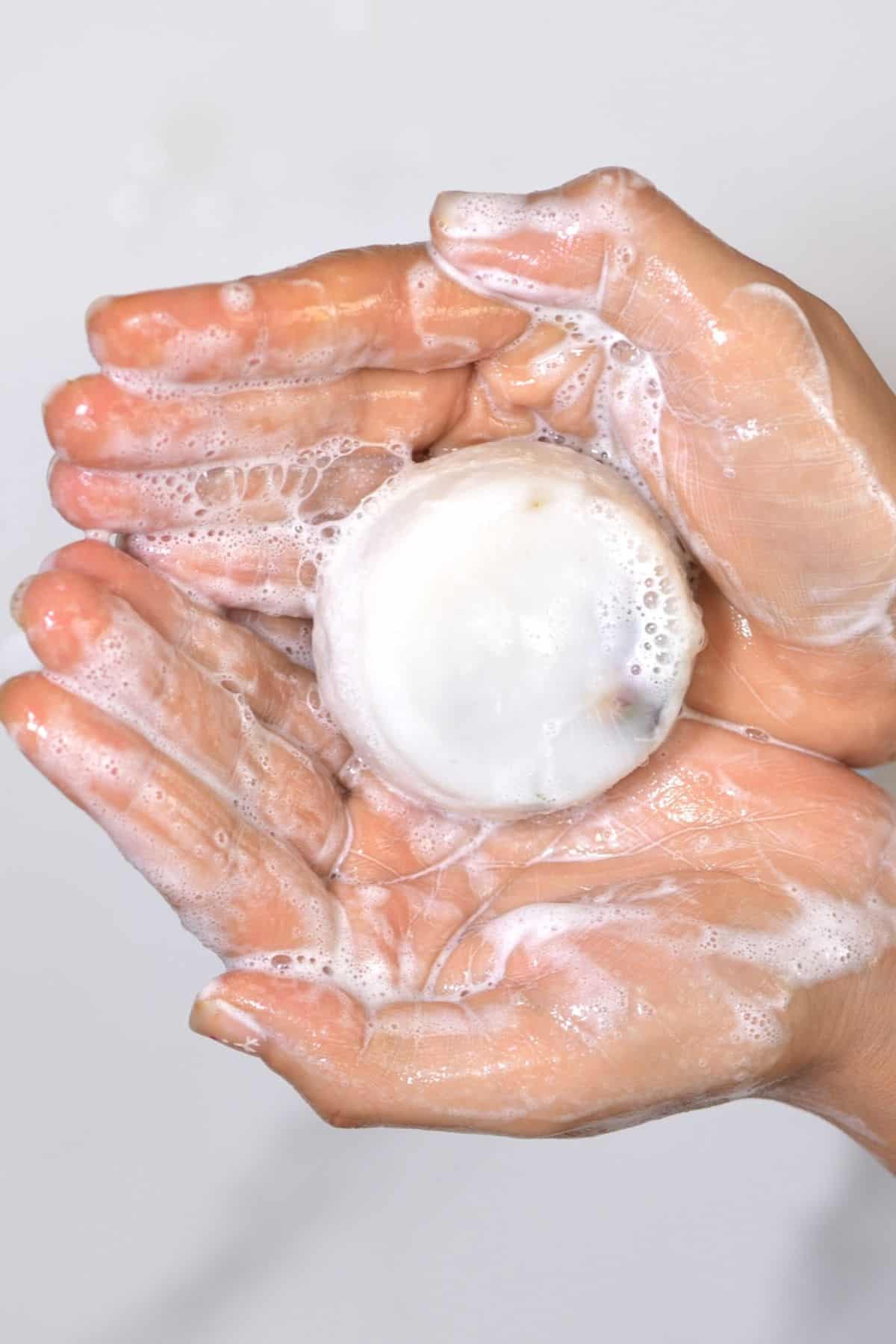
Alternatively, you could use a little hydrogen peroxide/rubbing alcohol on cotton wool, to first try and rub away as much of the stain as possible.
As an extra step, you could create a lemon juice, baking soda “scrub” and gently rub it into your hands to try to lift some of the yellow pigment.
From Dishes & Blenders/Food processors
Turmeric can stain all sorts of materials. However, the below method works particularly well for glazed ceramics, glass, and plastic (like your blender/food processor). Before trying the below, you can rinse your item/s out and wash as normal with dish soap and warm water. If the stain is still there, then try the below.
Top Tip: To reduce the risk of staining, it’s best to store any leftovers with turmeric in food-grade stainless steel containers.
- Soak the stained item in a hot water/vinegar bath. I recommend using a 2:1 ratio of water to pure white vinegar and a few drops of dish detergent. Then leave the item/s to soak overnight.
- The next morning, rinse out the mixture and then wash with detergent and water.
- You can also, then leave the item/s to air dry in the sunshine, where the sun will help to naturally bleach the stain. This can take time, but if you don’t need the item/s immediately, it’s a great “hands-off” way to remove turmeric stains.
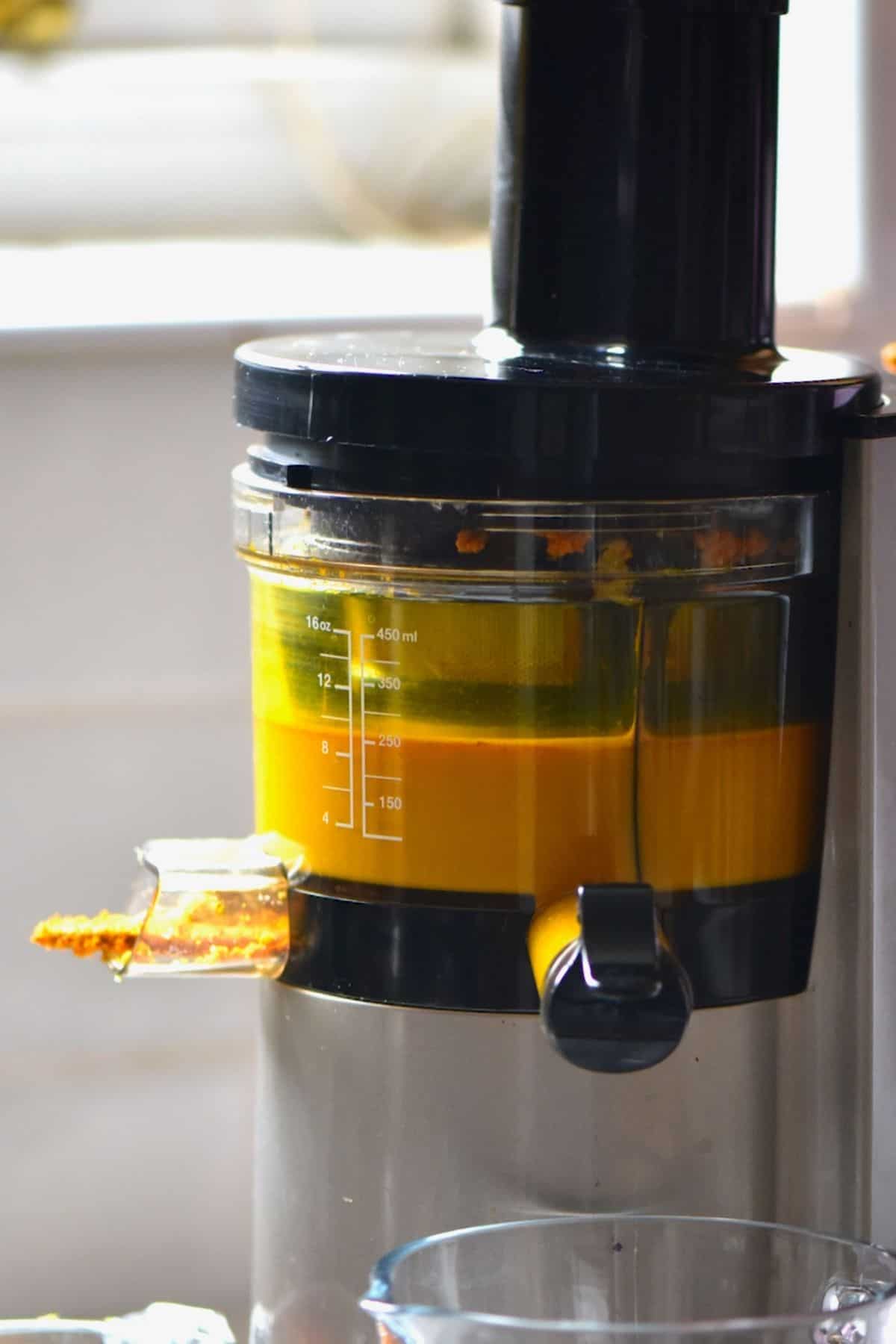
You can also use bleach or hydrogen peroxide – which will likely work better/quicker. However, I try to avoid using bleach with anything that I use around food. A Magic Eraser can also be used for particularly stubborn stained spots on your dishes. Alternatively, some rubbing alcohol can help.
How to Get Turmeric Stains Out of Clothes and Linens
The very top tip here is to act fast. The longer the stain has to sit on the fabric, the harder it will be to remove. Plus, turmeric is used as a fabric dye in many countries because of how hard it is to remove once set, so – let’s not let it set!
Top Tip: Never use warm/hot water to deal with material stains, as it will cause it to set! Use only cool/cold water.
For oil-based stains (like curry sauce):
- You’ll want to pre-treat these stains, to remove the oil as well as the turmeric stain.
- First, use a spoon or knife to remove any excess (i.e. if there’s curry on the item).
- Then, use either cornstarch, baking soda, or flour to liberally sprinkle (packed) over the stain. Leave for 20 minutes. You should see the powder start to soak up the excess liquid. If you’re out (i.e. at a restaurant), then ask for lemon or lime and use that to apply to the stain (then blot away after 15-20 minutes with a damp napkin).
- Then, after the 20 minutes, you should be able to brush away the excess powder.
If your stain isn’t oil-based, then you can skip the above step and move straight on to the below.
Pre-treat the turmeric stain:
There are two ways to do this – either with liquid detergent or lime juice/vinegar.
- Pour some of the liquid directly over the stain and then use either your fingers or an old toothbrush/damp towel (gentle) to gently rub into the material with your fingers (be careful when doing this so you don’t damage the fabric). Then rinse the area with cool water and repeat if needed.
- Alternatively, you could submerge the stained part of the material into a bowl of white vinegar and leave it to soak for around an hour.
If your material is all white, you could optionally use bleach to remove the stain. However, don’t use it on any colored materials as it will likely ruin them.
Wash the material:
- Make sure to wash your stained item on the cold-water cycle in your machine with your usual laundry detergent (or an anti-stain one, if you want a little extra boost).
- Then, if possible, hang the item/s up in the sunshine and allow to dry in the sunlight for at least 6 hours (which will further naturally “bleach” the stain. However, be careful doing this with certain clothing, as their colors will also naturally lighten in the sun.
If necessary, you may need to wash the item a second time (or possibly a third).
Note: certain fabrics (such as silk) will require more specialized care. It’s best to avoid wearing these when dealing with turmeric. However, if you have, then it may be best to take it to a professional dry cleaner after a small soak. If you’re out of the house when a spill happens, it’s always a good idea to keep a stain remover pen in your bag!
Bonus: removing turmeric stains from carpet
While not as likely as general line/clothing, it can happen. Here’s what to do:
- First, remove as much of the “excess” as possible. If it’s dry turmeric, then use a hoover. If it’s wet, then use a spoon. Then use a damp tower to blot (not scrub) the stain with cool (not warm) water.
- Next, make a paste with a combination of water, baking soda, and just a drop or two of liquid dish soap. Add it to the stain and leave it to sit for 10-15 minutes.
- Then, remove the excess paste with a spoon/cloth and then blot the area once more (with a clean part of the towel).
If the stain lingers, you can try a professional stain remover. Otherwise, you may need a professional carpet cleaner.
From Countertops and Chopping Boards
When it comes to countertops (and wooden surfaces), it’s important to use materials that are safe for your particular surface. You don’t need to be quite as “delicate” as when you deal with fabric. Thus, a little “scrubbing” is fine. Just make sure not to use materials that are too abrasive. I recommend a sponge or abrasive pad but avoid steel wool, etc.
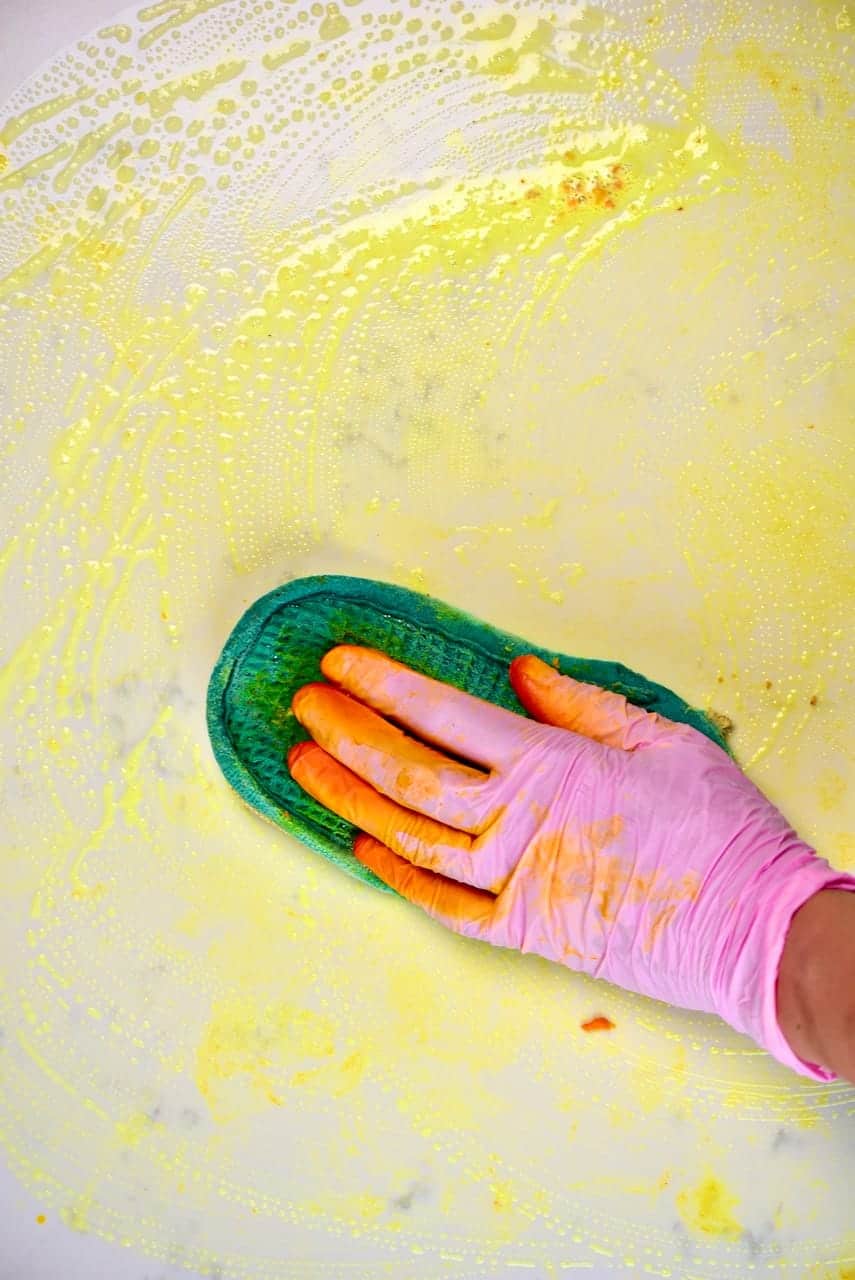
With natural stone countertops (including granite and marble), avoid using highly abrasive materials (which can scuff/scratch them) and avoid vinegar/lemon juice.
- First, make a paste using a 1:1 ratio of baking soda and water.
- Apply the paste to your countertop (liberally) and leave it to sit for 15 minutes.
- Then, use a damp/wet cleaning cloth to gently scrub the surface and wipe it away (or rinse it under a sink, if possible). For extra cleaning power, then you can add a little lemon juice or vinegar before scrubbing.
If the stain remains, you could then use a little lemon juice/vinegar or rubbing alcohol to scrub once more OR use a Magic Eraser (as long as it’s fine for the surface type).
If you’re able to (for example with small cutting boards, etc.) then leave the item out in the sunlight to naturally fade the stain.
How to Use Turmeric?
And now that you’ve sorted out your turmeric stain issue, let’s make some more stains! Just kidding – however, here are several ways you can use turmeric (carefully) and keep on enjoying this healthful ingredient!
- How to make turmeric powder
- How to juice turmeric (with and without juicer)
- DIY turmeric tincture (Nature’s Golden Medicine)
- Simple turmeric paste
- Turmeric honey paste
- Ginger Pumpkin immune-boosting soup
- Golden milk
- Roasted whole cauliflower head
- Turmeric rosemary no-knead focaccia
Other Kitchen DIYs and Cleaning Hacks
- How To Clean A Microwave With Lemon (Clean Microwave Hack)
- How to Clean an Oven (naturally)
- How to Clean An Electric Kettle
- Non-Toxic Natural All-Purpose Citrus Cleaner
- How to Clean A Wooden Cutting Board (And Season It)
- How to Paint a Refrigerator (Low-budget Retro Refrigerator)
If you try any of these methods for how to remove turmeric stains, I’d love to hear your thoughts/questions below. Also, I’d appreciate a recipe card rating below, and feel free to tag me in your recipe recreations on Instagram @Alphafoodie!

How to remove turmeric stains from clothes/linen
Ingredients
- 1-2 tsp baking soda or cornstarch to soak up the excess turmeric
- 1-2 Tbsp lemon juice or white vinegar or liquid detergent to pre-treat the stain
Instructions
- The very top tip here is to act fast. The longer the stain has to sit on the fabric, the harder it will be to remove. Top Tip: never use warm/hot water to deal with material stains, as it will cause it to set! Use only cool/cold water.
For oil-based stains (like curry sauce):
- You’ll want to pre-treat these stains, to remove the oil as well as the turmeric stain. Use a spoon or knife to remove any excess (i.e. if there's curry on the item). Then, use either cornstarch, baking soda, or flour to liberally sprinkle (packed) over the stain.
- Leave for 20 minutes. You should see the powder start to soak up the excess liquid. If you're out (i.e. at a restaurant), then ask for lemon or lime and use that to apply to the stain (then blot away after 15-20 minutes with a damp napkin).
- After 20 minutes, you should be able to brush away the excess powder.If your stain isn't oil-based, then you can skip the above steps and move straight on to the below.
Pre-treat the turmeric stain:
- There are two ways to do this – either with liquid detergent or lime juice/vinegar.Pour some of the liquid directly over the stain and then use either your fingers or an old toothbrush/damp towel (soft) to gently rub into the material with your fingers (be careful when doing this so you don’t damage the fabric).
- Rinse the area with cool water and repeat if needed. Alternatively, you could submerge the stained part of the material into a bowl of white vinegar and leave it to soak for around an hour.If your material is all white, you could optionally use bleach to remove the stain. However, don’t use this on any colored materials as they will likely ruin.
Wash the material:
- Make sure to wash your stained item on the cold-water cycle in your machine with your usual laundry detergent (or an anti-stain one, if you want a little extra boost). Then, if possible, hang the item/s up in the sunshine and allow to dry in the sunlight for at-least 6 hours (which will further naturally ‘bleach’ the stain. However, be careful doing this with certain clothing, as their colors will also naturally lighten in the sun.If necessary, you may need to wash the item a second time (or possibly a third).

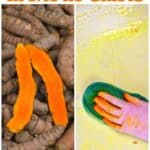





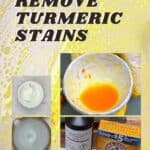
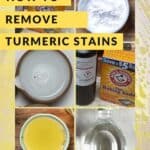









Hello, this is was amazing. I will try this method to my nut cloth , there were so much turmeric stains after i made nut mylk. What if the stains remain on the nut cloth? Is it safe to use it again?
Such A Great Blog. Thank U For Sharing Useful Information.
This Article Really Amazing And So Much Helpful For Me. In fact, I found the information I was looking for in your article.
It’s really helpful. I have benefited from reading your article. Thank you very much.
Thank you so much for your comment, Tiffany!